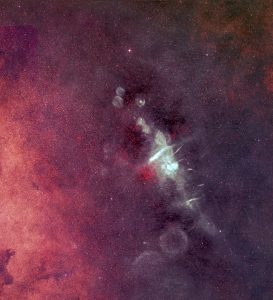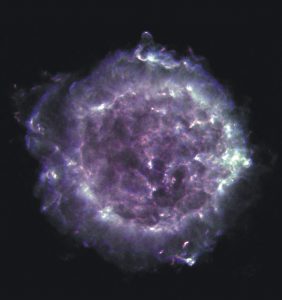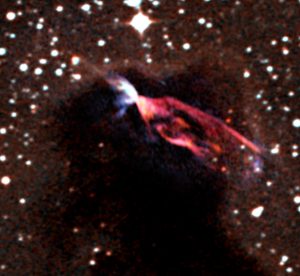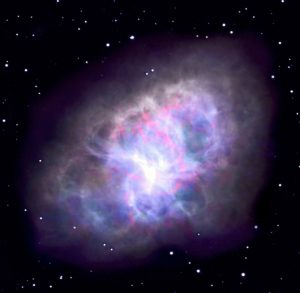The Very Large Array (VLA) was used to make the largest and most sensitive radio image of the Milky Way Galaxy’s center. The bright diagonal features trace our Galaxy’s disk-like shape viewed edge-on. The brightest source is called Sagittarius A. (The Galaxy’s center lies toward the constellation Sagittarius, or Sgr.) Deep within Sgr A is Sgr A*, a black hole with a mass millions of times that of the Sun. Hot young stars heat the gas around them in bright, round blobs. Massive supernovae explosions leave bubble-shaped remnants. Spiraling or synchrotron radiation makes a collection of strange, thread-like structures. Their emission, orientation, and structure provide important clues about the energetics and large-scale magnetic field structure.


Cassiopeia A
Cassiopeia A is the remnant of a supernova explosion that appeared in our sky over 300 years ago in our Galaxy, at a distance of about 11,000 light years from us. Its name is derived from the constellation in which it is seen: Cassiopeia, the Queen. A supernova is the explosion that occurs at the end of a massive star’s life; and Cassiopeia A is the expanding shell of material that remains from such an explosion. This radio image of Cassiopeia A was created with the National Science Foundation’s Very Large Array telescope in New Mexico. Cassiopeia A is one of the brightest radio sources in the sky, and has been a popular target of study for radio astronomers for decades. The material that was ejected from the supernova explosion can be seen in this image as bright filaments.

ALMA Observes Supernova 1987A
Composite image of supernova 1987A. ALMA data (red) shows newly formed dust in the center of the remnant. HST (green) and Chandra (blue) show the expanding shockwave.

Starless Cloud Cores
This image shows the ALMA data overlaid on an artist’s impression background. The ALMA data show two main cores as imaged by emission from the molecular ion N2D+ (two nitrogen and one deuterium atom). The core on the right is particularly bright and rounded, suggesting it is self-gravitating and poised to form a massive, single star – a very rare occurrence in star formation. The other core appears more distorted and fragmented, potentially leading to the formation of multiple lower-mass stars. This fragmentation is a normal process in star-forming clouds.

Powerful Jets of Young Stars
Inside a gigantic cloud of dark molecules and gas is a pair of young stars known as HH46/47. One of these stars is going through a normal but violent phase where its magnetic poles act like railways to channel charged particles away from the star. ALMA observed tons of molecules traveling out of this star along these jets at superfast speeds. These outflows eventually distort and help clear away the cloud from around the star. In this false-color image from ALMA, blue shows jet material heading toward us and red marks the jet particles speeding in the opposite direction.

Crab Nebula
The Crab Nebula, located in the constellation of Taurus, is the remnant of a star that exploded in 1054 AD. The nebula is roughly 10 light-years across, and it is at a distance of about 6,000 light years from earth. It is presently expanding at about 1000 km per second. The supernova explosion left behind a rapidly spinning neutron star, or a pulsar (not discernible in this image). The present remnant is formed from both the material originally thrown off by the star in the supernova explosion, and from a highly energetic wind from the pulsar. It is this wind which energizes the nebula, and causes it to emit the radio waves (purple, blue, green). Gases glow so brightly that they can be seen optically as well (red).





